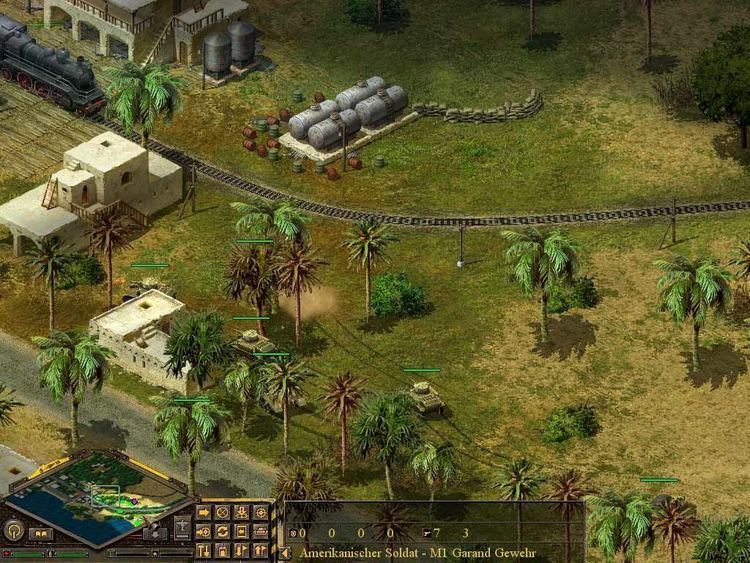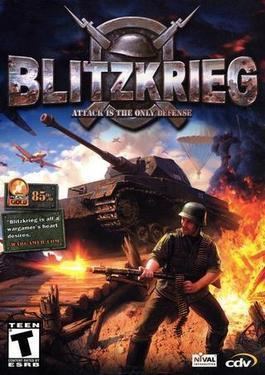9 /10 1 Votes
Engine Enigma engine | 9/10 Steam Release date(s) June 4, 2003 Initial release date 2003 Developer Nival | |||||||||||||||||||||||||||||||||
 | ||||||||||||||||||||||||||||||||||
Designers Igor Petukhov, Alexander Vinnikov, Dmitry Devishev, Boris Yulin, Serge Orlovsky Similar Blitzkrieg games, Nival games, Real-time strategy games | ||||||||||||||||||||||||||||||||||
Blitzkrieg (Russian: Блицкриг) is a real-time tactics computer game based on the events of World War II and is the first title in the Blitzkrieg series. The game allows players to assume the role of commanding officer during the battles of World War II that occurred in Europe and North Africa. Each country has its respective historically correct military units. Similar to the Sudden Strike games Blitzkrieg focuses on battles rather than real-time strategy aspects like base building.
Contents

Virtual Programming published a Mac OS X version of the game on the Mac App Store on April 20, 2011.

Certain versions of the original game, and several sequels, use the StarForce copy protection system. Blitzkrieg Anthology does not appear to use Starforce.

Graphics deliver realistic 3-D rendered isometric terrain and details include seasons, climatic zones and weather conditions which can affect game play. Blood is present although it can be deactivated. The game features over 350 different units and objects. The player has the ability to build pontoon bridges, dig trenches, lay mines, resupply and repair units or call in air support but there are no resources. Virtually everything can be destroyed including buildings and bridges. Forests can be flattened by tanks or artillery. Each unit of a respective nation speaks its own language, adding immensely to the immersion.
The game shipped with a mission and resource editors for users to create their own units and maps.
Gameplay

Blitzkrieg centers on 3 distinctive campaigns which features some of the major factions battling it out in World War II. The 3 campaigns featured the Allies (American and British campaigns), the Germans and the Soviets. Each of these campaigns attempt to chronologically re-enact the time periods of the war by devising Chapters into each of the campaigns. Other nations featured include Poland, France, and Italy.

These Chapters, in turn, feature smaller scale random (i.e. fictional) and historical battles. Random maps present an opportunity for the player to win upgrades for his side as depicted in the map description. Depending on the random map selected, the player may potentially bolster his forces with either artillery units or armored units.
Each player starts with 'core units'. These named units would be the same personnel accompanying the player throughout the chosen Campaign and may gain rank and experience as the player progresses from one Chapter to the other. The player initially starts off with 3 armored core units and 3 artillery core units and would eventually gain command of six core units of each category in later Chapters. Core units gaining rank would perform better in combat, with artillery personnel being more accurate in their shots and tank crews doing likewise.
The game has relatively low end system requirements considering its graphics and capabilities.
Strategy
Because of the dismissal of base-building and unit spawning, strategy is a key ingredient of overall gameplay. Sending out all units at once will most likely end in the massacre of the foresaid army. The timing, unit locations, artillery and air support and much more are key to victory. For example:
• Bombarding the enemy with artillery will knock out key anti-tank and anti-infantry obstacles, but may also expose said artillery to enemy counterbattery fire.
• Immobilising enemy vehicles requires flanking and correct timing.
• When defending, mines and Czech hedgehogs must be placed in strategic positions in the time window allocated before the enemy attack.
• The precise location and use of landmines, trenches and barbed wire fencing is important when defending the perimeter of a built up area.
• Air support offers help from Paratroopers, Reconnaissance, Heavy bombers, Close air support (mainly Dive bombers) and Fighter aircraft.
Add-ons
There are three official expansions of the original Blitzkrieg to date, all three were developed by La Plata Studios (Germany) in collaboration with Nival Interactive, the developer of the original Blitzkrieg game. They are published and distributed by CDV Interactive. The base game Blitzkrieg was released together with its three expansions as Blitzkrieg Anthology.
Stand-alone games
Panzerkrieg - Burning Horizon II
In October 2007 Hamburg-based La Plata Studios (developers of the Burning Horizon, Rolling Thunder and Green Devils titles) announced that Panzerkrieg - Burning Horizon II would be released during 2008. Initial details are few and far between but, as the project is being produced in conjunction with the head of the original Blitzkrieg team, it is likely to be more than a standard expansion or stand-alone title. End of October 2008 the game was released in Germany where it was very successful and sold more game copies than any Blitzkrieg 2 extension.
